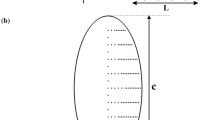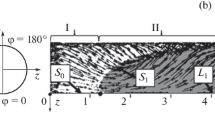Abstract
Vortex asymmetry develops on slender bodies at high angles of incidence, leading to large side-forces and yaw moments even in symmetrical flight conditions. In the present experimental study, the flow over a slender body consisting of a conical forebody and a cylindrical aftbody is studied at high angles of incidence at low speeds. Experiments consisted of force measurements using a six-component strain gauge balance and velocity field using Particle Image Velocimetry. Results show that a pair of counter-rotating vortices develop nearly symmetrically over a polished cone but become asymmetric over the cylinder. Several secondary shear-layer vortices develop at the cone–cylinder junction and over the cylinder due to sharp turning angle, surface imperfections, and joints. These secondary shear-layer vortices then merge with the primary vortex pair, leading to the flow asymmetry. The flow characteristics and side-forces vary significantly when the conical forebody is rotated about its axis of symmetry and set to different azimuthal positions. The results strongly suggest that a change in the geometry at the cone–cylinder junction and surface imperfections present on the cylindrical aftbody play an important role in determining the overall flow-asymmetry and the magnitude of side-forces generated on the slender body at high angles of incidence.
Graphic abstract





























Similar content being viewed by others
References
Champigny P (1994) Side forces at high angles of atack. why, when, how. La Rech Aerosp 4:269–282
Degani D, Tobak M (1992) Experimental study of controlled tip disturbance effect on flow asymmetry. Phys Fluids Fluid Dyn 4(12):2825–2832
DeSpirito J (2017) Cfd aerodynamic characterization of 155-mm projectile at high angles-of-attack. In: 35th AIAA applied aerodynamics conference, AIAA paper 2017–3397
Ericsson LE, Reding JP (1992) Asymmetric flow separation and vortex shedding on bodies of revolution. Prog Astronaut Aeronaut 141:391–452
Fagley C, Porter C, McLaughlin T (2014) Experimental closed-loop flow control of a von kármán ogive at high incidence. AIAA J 52:2891–2898
Guan X, Xu C, Wang Y, Wang Y (2009) Influence of nose-perturbation location on behavior of vortical flow around slender body at high incidence. Sci China Ser E Technol Sci 52(7):1933–1946
Guha TK (2017) Active control of wingtip vortices using piezoelectric actuated winglets. PhD thesis, Florida State University
Harada T, Kawauchi K, Kitamura K, Nonaka S (2019) Side force characteristics of supersonic flight vehicle equipped with asymmetric protuberance. In: AIAA Scitech 2019 Forum, AIAA 2019–0299
Hummel D (1979) On the vortex formation over a slender wing at large angles of attack, high angle of attack aerodynamics. AGARD Paper 15:247
Hunt B (1982) Asymmetric vortex forces andwakes on slender bodies. In: 9th Atmospheric flight mechanics conference, AIAA Paper 1982–1336
Keener ER, Chapman GT (1974) Onset of aerodynamic side forces at zero sideslip on symmetric forebodies at high angles of attack. In: Mechanics and control of flight conference, AIAA Paper 1974-0770
Kumar R, Viswanath P, Ramesh O (2005) Nose bluntness for side force control on circular cones at high incidence. J Aircr 42:1133–1141
Kumar R, Viswanath P, Ramesh O (2008) Nose blowing for side force control on slender cones at high incidence. J Aircr 45:1156–1166
Mahadevan S, Rodriguez J, Kumar R (2018) Effect of controlled imperfections on the vortex asymmetry of a conical body. AIAA J 56:1–18
Malcolm GN (1991) Forebody vortex control. Prog Aerosp Sci 28(3):171–234
Porter C, Seidel J, Fagley C, Farnsworth J (2012) Vortex dynamics of a tangent ogive at a high angle of attack. In: 6th AIAA flow control conference, AIAA Paper 2012–2953
Sohail M, Chao Y, Ullah R, Yamin M (2011) Computational challenges in high angle of attack flow. World Acad Sci Eng Technol 80:1148–1155
Taligoski J, Fernandez E, Kumar R (2014) Experimental investigation of vortex asymmetry on a conical forebody at high angles of incidence. In: 52nd Aerospace sciences meeting, AIAA Paper 2014–0051
Taligoski J, Fernandez E, Uzun A, Kumar R (2015) Study of the roll orientation effects on vortex asymmetry on a conical forebody at high angles of incidence. In: 53rd AIAA aerospace sciences meeting, AIAA Paper 2015–0547
Ward KC, Katz J (1989) Development of flow structures in the lee of an inclined body of revolution. J Aircr 26:198–206
Wieneke B (2015) Piv uncertainty quantification from correlation statistics. Meas Sci Technol 26:074002
Williams DR (1982) A review of forebody vortex control scenarios. In: 28th Fluid dynamics conference, AIAA Paper 1997-1967, 1997
Xueying D, Yankui W (2004) Asymmetric vortices flow over slender body and its active control at high angle of attack. Acta Mech Sin 20(6):567–579
Acknowledgements
The authors would like to thank the U.S. Army Research Office for their financial support under contract W911NF-15-1-0583 managed by Dr. Matthew Munson. We are grateful for their support. The machining assistance of FCAAP machinist, Mr. Jeremy Phillips, as well as the assistance of the wind tunnel engineers Mr. John Strike and Mr. Alex Karns in design and test execution, is also gratefully acknowledged.
Author information
Authors and Affiliations
Corresponding author
Additional information
Publisher's Note
Springer Nature remains neutral with regard to jurisdictional claims in published maps and institutional affiliations.
Rights and permissions
About this article
Cite this article
Kumar, R., Guha, T.K. & Kumar, R. Role of secondary shear-layer vortices in the development of flow asymmetry on a cone–cylinder body at high angles of incidence. Exp Fluids 61, 215 (2020). https://doi.org/10.1007/s00348-020-03045-y
Received:
Revised:
Accepted:
Published:
DOI: https://doi.org/10.1007/s00348-020-03045-y




